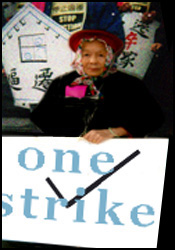HUD's "one strike" eviction policy is analogous to Federally mandated gentrification
 |
|
by Leo Stegman In a case that will have a lasting and long term affect on public housing residents throughout the Western section of America, the United Sstates Ninth Circuit Court of Appeals has decided to reconsider its previous ruling upholding the drug activity provision of the Oakland Housing Authority (OHA). The first to be affected by its decision to uphold this provision will be elderly tenants. They are currently fighting the eviction process which is based on a family member and/or a guest being accused of unlawful drug activity. The defendants further states that they had not known about the activities of the family member alleged by OHA. In September of 1999, United States District Court Judge Charles Breyer issued a preliminary injunction prohibiting OHA from evicting tenants from public housing for the drug activity of their guests or member of the household, even if the tenants had no knowledge of the drug activity that allegedly took place. However, OHA appealed the District Court's ruling. In February of 2000, a three judge panel of the Ninth Circuit Court of Appeals, by a 2-to-1 margin, reversed the lower court’s decision and upheld OHA's termination of tenancy of the four defendants. With a seldom used "en banc" procedure, a majority of the 24 judges of the Ninth Circuit voted to withdraw the previous decision of the Court, which upheld OHA's "one strike" eviction policies. The case of Rucker v. Davis will now be heard by an eleven judge "en banc" panel. The "one strike" eviction law arise from a 1996 election-year promise by President Bill Clinton to make public housing safer for its residents. He ordered Secretary Henry Cisneros to implement a policy of guidelines, procedures, rules and regulations to make it easier to evict public housing residents accused of criminal activity. That was referred to as "one strike.” The Clinton Administration went a step further. Working with the Republican controlled United States Congress, the self proclaimed "new Democrat,” Bill Clinton signed legislation into law that gave the public housing agencies the statutory authority to evict public housing residents that they determined to be involved in criminal- or drug-related activity. The March 1998 amendment to the existing Federal Statutes, United States Code Services, Title 42 Section 1437(d), establishes "good cause" for terminating a resident of public housing tenancy. The statute states: Any criminal activity that threatens the health, safety, or right to peaceful enjoyment of the premises by other tenants or any drug related activity on or off the premises, engaged by a public housing tenant, any member of tenant's household, guest of other person under tenant's control, shall be cause for termination of tenancy This law is at the foundation of the Federal " one strike" drug activity provision. it punishes innocent public housing residents for the alleged drug activity of their family members, guests or other persons considered under their control. Not one of the four residents in the case ofRucker has knowledge of the purported drug activity that took place. In the case of Pearlie Rucker, she was given a notice of termination of tenancy after her mentally disabled daughter was arrested for possession of cocaine three blocks away from her home. Willie Lee and Barbara Hill were given eviction notices after their grandsons, who live with them, were arrested for smoking in the housing project's parking lot. In the case of the fourth tenant, of Herman Walker , who is disabled, was ordered to be evicted after his caregiver came into his home with drugs and drug paraphernlia. Public housing officials, judges, attorneys, tenants rights advocates, and public housing residents are all eagerly awaiting the decision of this case. It will establish the type of rights public housing residents have throughout the Western United States under the drug activity provision of the "one strike" eviction laws. Many view the "one strike" law as being draconian, cold-hearted and evil. Others view the "one strike eviction" law and policies as an attack on poor folks in a bid to gentrify public housing projects. The Department of Housing was established on November 9, 1965, under the administration of Lyndon B. Johnson. The objective was to provide affordable housing to all Americans . Many of HUD's programs provide low-interest loans to low-income, middle- and first-time home buyers. Other programs are suppose to assist low-income families and individuals in their housing needs. Some feel that the Clinton Administration's "one strike" eviction policy is just the tool to redirect the resources of HUD to families making salaries closer to the median income levels. In San Francisco and the Bay Area, like most of the country, both rents and the prices of houses are spiraling out of control and out of the reach of even dual-income households. The purchase of a new home is out of the range of most families. According to the Association of Bay Area Governments report, the median household income for both Alameda and San Francisco counties is approximately $67,000.The median purchase price for a house in Alameda County in July of 2000 was $340,000, according to Data Quick Information System . The median purchase price for a house in San Francisco County for July of 2000 was $470,000. In a politically unstable economy, working class households in the Bay Area are having a harder time finding decent and affordable housing. The Clinton administration devised a federal plan to relocate the federal dollars to provided affordable and decent housing from the nations low-income households to moderate-income household which is tantamount to "Federally sponsored gentrification" of Federal public housing. HUD's gentrification plan manifests itself in two policies: the Hope IV Rehabilitation Project and the"One Strike" Eviction statutes. The Hope IV Project is a Federally funded program which remodels, rebuilds and rehabilitates existing Federal public housing. During most of the project, the current tenants are relocated from their existing homes, without receiving an offer to move back into their old apartment. Remodeled and rehabilitated public government subsidized housing takes on a different character than the old housing. It has more middle class families. The "one strike" eviction law allows the Federal Government to move out long term tenants, usually low income families, and replace them with moderate income families. Thus,the Federal Government is doing the same thing that gentrification does in urban areas. They are taking so-called distressed neighborhoods- in this case public housing projects- and are moving out the low-income families, remodeling them and replacing them with moderate income families. A favorable ruling for the tenants in Rucker v. Davis will take away one tool from the Federal gentrification process, and help preserve affordable housing for low income tenants who are hurt the most in this nation wide housing crunch. |



